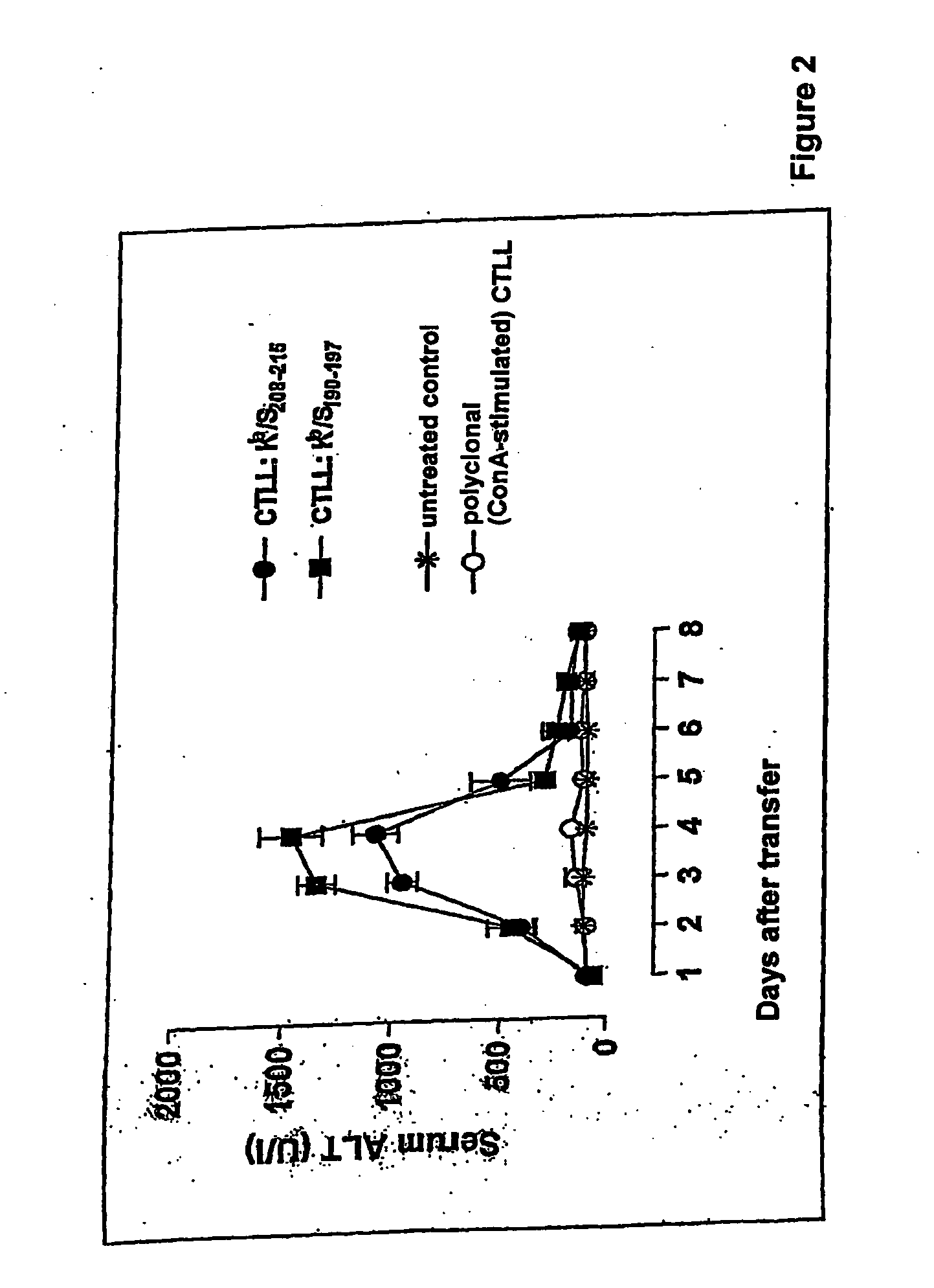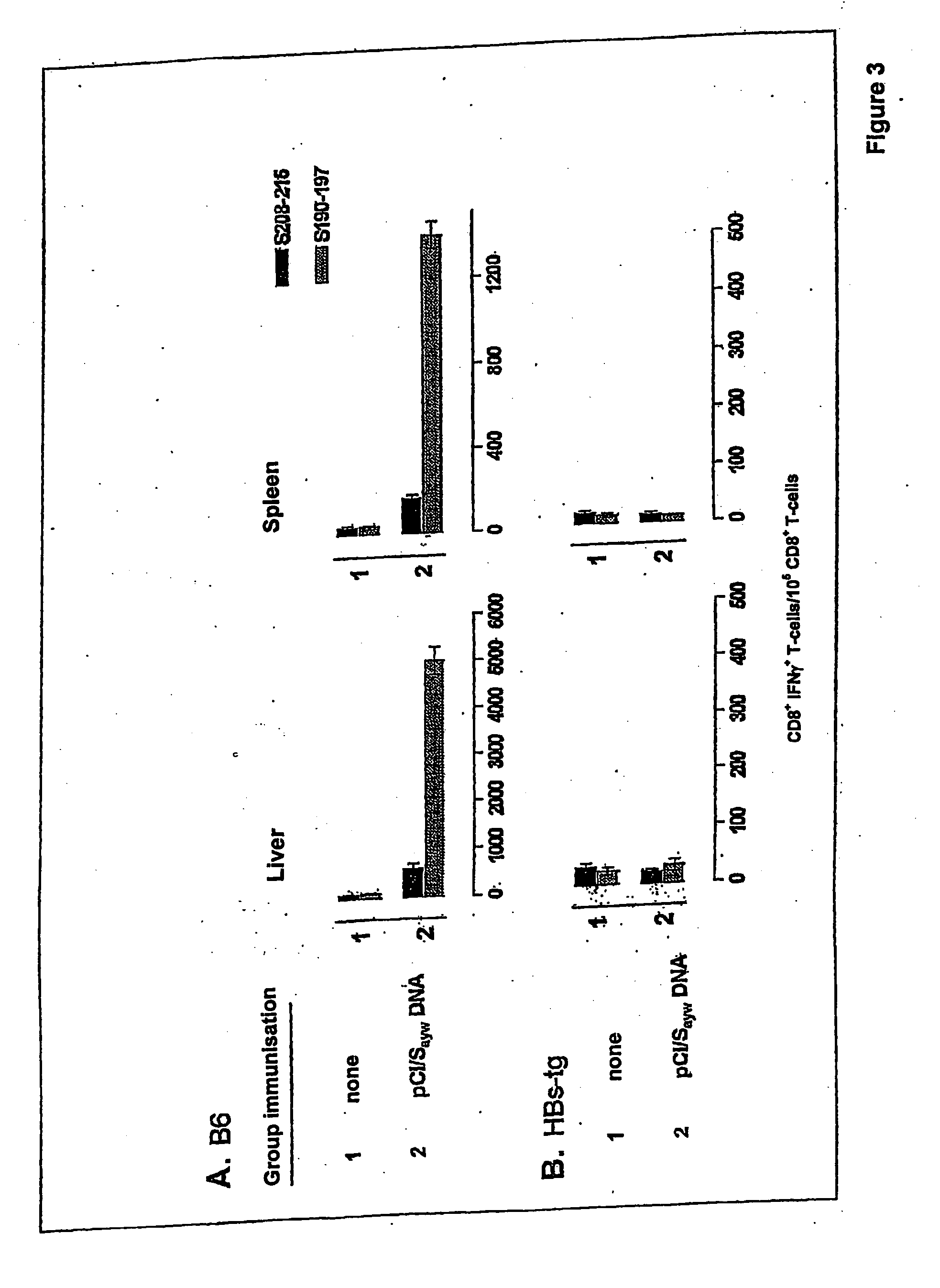Composition for the prophylaxis and treatment of HBV infections and HBV-mediated diseases
a technology for hbv infections and hbv-mediated diseases, applied in the direction of viruses, drug compositions, immunological disorders, etc., can solve the problems of limited s-protein diversity of hbv-isolates of different subtypes and genotypes, no known vaccine for chronically persistent hepatitis treatment, and 5% of people that are immunised
- Summary
- Abstract
- Description
- Claims
- Application Information
AI Technical Summary
Benefits of technology
Problems solved by technology
Method used
Image
Examples
example 1
[0090] Adoptive transfer of Kb-restricted CD8+ T-cell lines that are specific to epitope 1 or epitope 2 induce liver damage in HBs-tg B6 mice
[0091] Short-term CD8+ T-cell lines were produced that are specific to epitope 1 or epitope 2 (FIG. 1B) of HBsAg from the spleen of B6 mice and that were immunised with pCI / Sayw plasmid DNA. Within those lines, >95% of the cells were CD8+, and the specific IFNγ expression was induced in >80% of those CD8+ T-cells. The adoptive transfer of 5×106 cells of those lines into congenic B6 hosts that expressed HBsAgayw in the liver from a transgene induced acute liver damage, as was revealed by a short, but large rise in serum transaminase (FIG. 2). The serum transaminase level normalised 5-6 days after the transfer, at which time no transferred CD8+ T-cells were detectable in the host. Transfer of the same number of polyclonal (mitogen-activated) CD8+ T blasts did not exhibit liver damage. It was therefore ascertained that (i) specific CD8+ T-cells e...
example 2
Kb-Restricted CTL that Recognise the HBsAg Epitopes 1 and 2 were Observed in the Spleen and Liver
[0092] An investigation was carried out into whether vaccine-primed HBsAg-specific CD8+ T-cells have access to the liver in normal or transgenic HBsAg-expressing (HBs-tg) B6 mice (FIG. 3). Spleen cells and non-parenchymal liver cells (NPC) were isolated from B6 mice that had been immunised 12-15 days beforehand with the pCI / Sayw vaccine. CD8+ T-cells that were specific to epitope 1 or epitope 2 were found in spleen and liver CD8+ T-cell populations from normal B6 mice (FIG. 3A). Although the frequency of HBsAg-specific CD8+ T-cells within the liver CD8+ T-cell populations was high, their absolute numbers were smaller than in the spleen (data not shown). In contrast, no CD8+ T-cell reactivity was demonstrable in HBsAgayw tg B6 mice that had been immunised with the DNA vaccine encoding HBsAgayw (FIG. 3B). Neither three booster injections (at three-week intervals) with the DNA vaccine nor ...
example 3
Kb-Restricted T-Cell Responses to the Epitopes of HBsAgayw and HBsAGadw2 Variants
[0093] The HBsAgayw and HBsAgadw2 proteins from the HBV isolates, which proteins have 226 amino acid residues, differ in 16 amino acid residues (their amino acids accordingly being 93% identical). The sequence of the HBsAgayw protein that was used is identical to the sequence of the transgene-encoded HBsAgayw expressed by the HBs-tg B6 mice. The sequences of the Kb-binding epitopes 1 and 2 of HBsAgayw and HBsAgadw2 that were selected differ by, respectively, 1 and 2 amino acid residues within the epitope, but have identical flanking sequences (FIG. 1A, B). The S208-215-epitope 1 of HBsAgayw and HBsAgadw2 differ in two positions: in adw2, a valine (V) residue is replaced by a leucine (L) at position 2, and an isoleucine (I) is replaced by a leucine (L) residue at position 6 (FIG. 1B). The binding affinity of epitope 1 of Kb was rather low; the HBsAgadw2 variant of epitope 1 exhibited higher binding affi...
PUM
| Property | Measurement | Unit |
|---|---|---|
| concentration | aaaaa | aaaaa |
| thick | aaaaa | aaaaa |
| composition | aaaaa | aaaaa |
Abstract
Description
Claims
Application Information
 Login to View More
Login to View More - R&D
- Intellectual Property
- Life Sciences
- Materials
- Tech Scout
- Unparalleled Data Quality
- Higher Quality Content
- 60% Fewer Hallucinations
Browse by: Latest US Patents, China's latest patents, Technical Efficacy Thesaurus, Application Domain, Technology Topic, Popular Technical Reports.
© 2025 PatSnap. All rights reserved.Legal|Privacy policy|Modern Slavery Act Transparency Statement|Sitemap|About US| Contact US: help@patsnap.com



